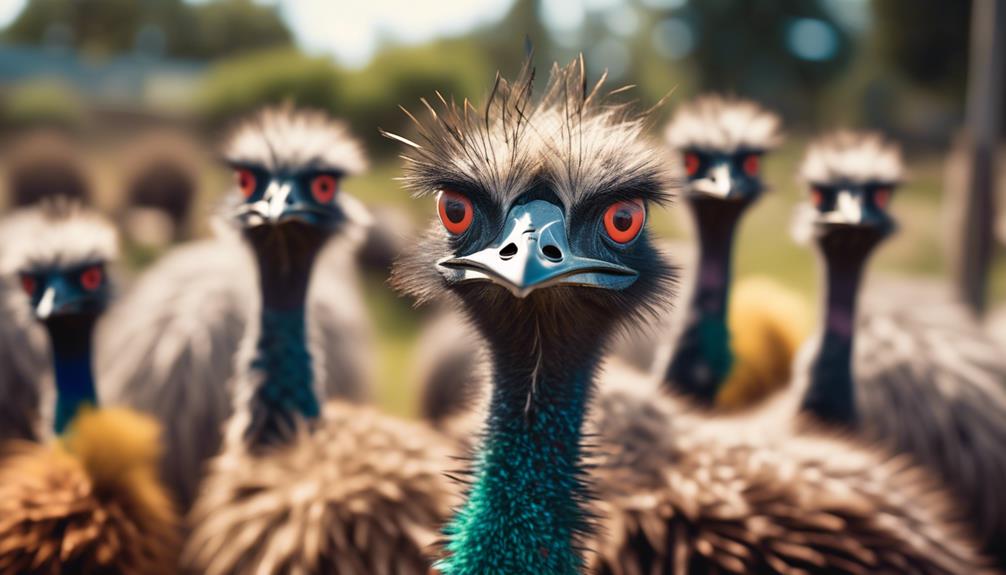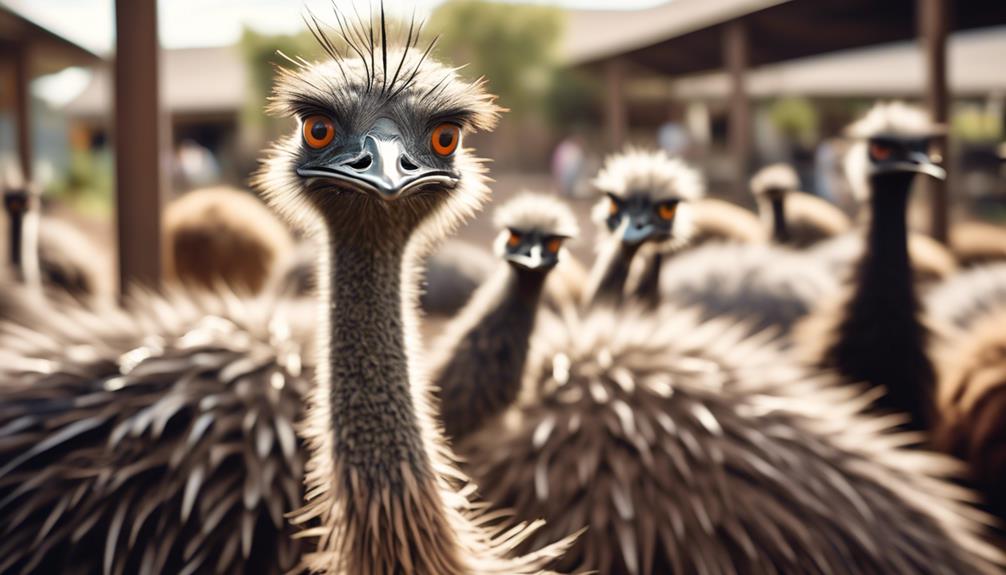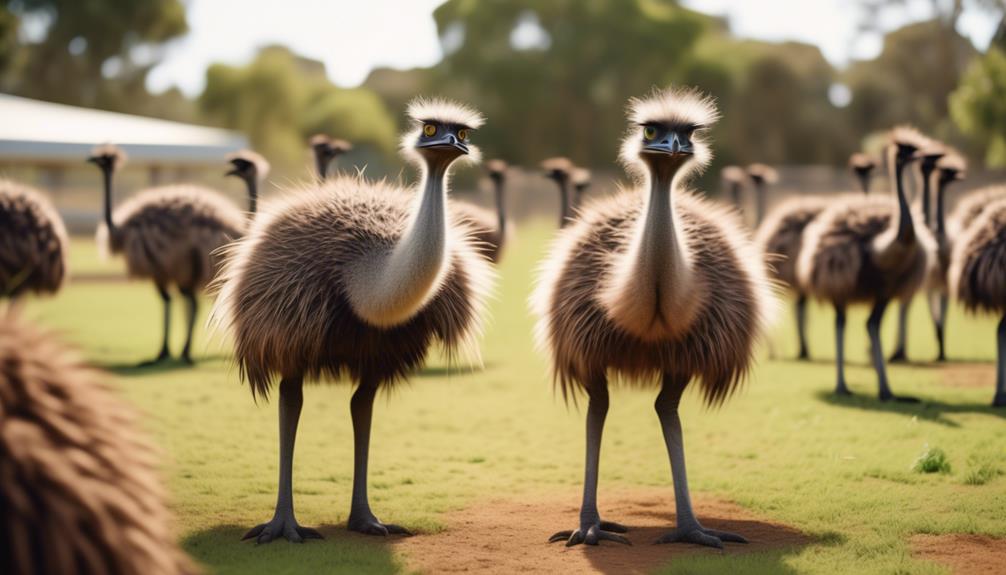
Picture a flock of emus, each one unique and distinct, a vibrant tapestry of feathers and traits. Like a symphony of varied melodies, the genetic diversity within this flock is essential for the health and success of emu farming.
But why is genetic diversity so crucial in this realm? How does it impact the resilience, productivity, and adaptability of these magnificent creatures?
In this discussion, we will explore the significance of genetic diversity in emu farming, uncovering the benefits it brings and the challenges it presents. Join us as we unravel the intricate tapestry of genetics and its profound implications for the future of emu farming.
The Role of Genetic Diversity in Emu Health

The genetic diversity of emus plays a crucial role in maintaining their overall health and well-being. Emu conservation efforts heavily rely on preserving genetic diversity within their populations. Genetic diversity refers to the variety of genes present in a population, and it's essential for the survival and adaptation of species.
Inbreeding, the mating of closely related individuals, can significantly impact the health of emus. Inbreeding reduces genetic diversity by increasing the chances of inheriting harmful genetic traits. Emus that are bred from closely related parents are more likely to have genetic disorders and reduced fitness. These disorders can manifest in various ways, such as compromised immune systems, decreased reproductive success, and higher susceptibility to diseases. Moreover, inbred emus may experience reduced genetic resilience, making them more vulnerable to environmental changes and less capable of adapting to new conditions.
To ensure the long-term survival of emus, preserving genetic diversity is paramount. Emu conservation programs focus on maintaining healthy breeding populations with diverse genetic backgrounds. By avoiding inbreeding and promoting outbreeding, conservationists can safeguard the genetic health of emus and enhance their ability to adapt to changing environments.
Benefits of Genetic Diversity in Emu Farming
Maximizing genetic diversity in emu farming offers a multitude of advantages for breeders and the overall success of their operations. By incorporating sustainable farming practices and improving productivity, breeders can ensure the long-term viability and profitability of their emu farms.
One of the primary benefits of genetic diversity is the increased adaptability and resilience of the emu population. Emus with diverse genetic backgrounds are better equipped to withstand environmental changes, diseases, and other challenges. This adaptability not only ensures the survival of the species but also minimizes the risk of losses for breeders.
Moreover, genetic diversity leads to improved productivity in emu farming. Emus with diverse genetic traits may exhibit enhanced growth rates, higher meat yields, and increased egg production. This translates to higher profitability for breeders, as they can produce more marketable products with less input.
To visualize the benefits of genetic diversity, consider the following table:
| Advantages of Genetic Diversity in Emu Farming |
|---|
| Increased adaptability and resilience |
| Improved growth rates and meat yields |
| Increased egg production |
Genetic Diversity and Disease Resistance in Emus

Emu breeders can enhance disease resistance in their emu population through the strategic implementation of genetic diversity. Genetic diversity plays a crucial role in the overall health and well-being of emus, as it affects their ability to combat diseases and maintain a strong immune system. By introducing genetic variation into the population, breeders can increase the chances of having emus with stronger immune responses and resistance to diseases.
Genetic diversity is closely linked to emu behavior and its impact on disease resistance. Emus with a higher genetic diversity exhibit a wider range of behaviors, such as foraging patterns and social interactions, which can contribute to their ability to avoid disease transmission. Different genetic backgrounds also result in variations in immune system function, making some individuals more resistant to specific diseases than others.
Furthermore, the impact of genetic diversity on emu meat quality shouldn't be overlooked. Emus with a higher level of genetic diversity tend to have better overall health and muscle development, which translates to higher quality meat. Genetic diversity ensures that the emu population isn't solely comprised of individuals with similar genetic traits, reducing the risk of inbreeding and associated detrimental effects on meat quality.
Enhancing Fertility Rates Through Genetic Diversity
To further optimize the breeding potential of emus, the successful manipulation of genetic diversity becomes paramount in enhancing fertility rates. Genetic diversity plays a crucial role in the overall health and reproductive success of emus. By ensuring a diverse gene pool, emu farmers can increase the chances of successful breeding and improve the overall productivity of their farms.
Enhancing fertility rates through genetic diversity involves carefully selecting breeding pairs that possess different genetic traits. This allows for the combination of favorable traits from both parents, resulting in offspring with enhanced fertility potential. By avoiding inbreeding and promoting genetic variation, emu farmers can reduce the risk of genetic disorders and improve the overall health of their flock.
In addition to improving fertility rates, genetic diversity also has an impact on the quality and taste of emu meat. Research has shown that emus with greater genetic diversity tend to have meat that's more tender and flavorful. This is believed to be due to the combination of different genetic traits related to muscle development and fat distribution.
Furthermore, genetic diversity also influences the variation in emu feather color. Emus with greater genetic diversity exhibit a wider range of feather colors, including shades of brown, gray, and black. This variation adds aesthetic appeal to the flock and increases the market value of emu products.
The Adaptability of Emus and Genetic Diversity

The adaptability of emus is closely linked to the genetic diversity within their population. Emus possess a remarkable ability to adapt to various environments and climates, which is largely attributed to their genetic makeup. Genetic diversity in emu breeding plays a crucial role in maintaining their adaptability and ensuring the overall health and vitality of the population.
To better understand the significance of genetic diversity in emu farming, let's take a closer look at the following table:
| Trait | Genetic Diversity | Importance |
|---|---|---|
| Disease Resistance | High | Emus with diverse genetic backgrounds are more likely to possess a wider range of immune responses, making them less susceptible to diseases. |
| Climate Adaptation | Moderate | Genetic diversity allows emus to have a higher chance of possessing traits that enable them to thrive in different climates, ensuring their survival in changing environmental conditions. |
| Reproduction | Low | Genetic diversity is less critical in terms of reproduction, as emus have relatively high fertility rates. However, maintaining genetic diversity is still important to prevent inbreeding and genetic disorders. |
| Growth Rate | Moderate | Genetic diversity can contribute to variations in growth rates among emus, allowing farmers to select individuals with desirable growth traits for commercial purposes. |
As you can see, the adaptability of emus is intricately tied to the genetic diversity within their population. By prioritizing genetic diversity in emu breeding, farmers can ensure the long-term sustainability and resilience of their emu farms.
Environmental Resilience and Genetic Diversity in Emu Farming
One key aspect of successful emu farming is the relationship between environmental resilience and genetic diversity.
Emus are highly adaptable birds capable of thriving in various environments. However, their ability to adapt and withstand environmental challenges is greatly influenced by their genetic diversity.
Genetic diversity refers to the variety of genetic material within a population. It's crucial for enhancing environmental sustainability and promoting the long-term viability of emu farming.
By maintaining a diverse gene pool, emu farmers can ensure that their birds possess the necessary traits to withstand changing environmental conditions. Genetic diversity allows emus to adapt to different climates, resist diseases, and tolerate fluctuating food availability. It also improves their ability to cope with environmental stressors such as temperature extremes and habitat alterations.
Furthermore, genetic diversity plays a significant role in the overall health and vitality of emu populations. It reduces the risk of inbreeding, which can lead to genetic disorders and weakened immune systems. With a diverse gene pool, emus are more likely to possess the genetic variations needed to survive and reproduce successfully.
The Economic Impact of Genetic Diversity in Emu Farming

Maintaining a diverse gene pool in emu farming has both environmental and economic benefits. One of the main reasons why genetic diversity is crucial for the economic success of emu farming is improved disease resistance. Emus with a diverse genetic makeup are less susceptible to diseases and infections, resulting in lower mortality rates and higher productivity. This reduces the need for costly veterinary treatments and ensures a healthier flock.
Another reason is increased market demand. Consumers are increasingly concerned about sustainable and ethical farming practices. Emu farms that prioritize genetic diversity can market their products as environmentally responsible and socially conscious. This attracts a larger customer base willing to pay a premium for high-quality, diverse emu products.
Genetic diversity also contributes to enhanced product quality. Emus with diverse genetic backgrounds tend to have better growth rates, higher fertility rates, and improved meat and oil quality. This translates into higher profits for emu farmers who can command better prices in the market.
Lastly, genetic diversity allows emu farmers to selectively breed for specific traits. This breeding versatility enables farmers to adapt to changing market demands and achieve a competitive advantage over farms with limited genetic variation. They can selectively breed for traits such as better meat yield or oil content, giving them the flexibility to meet market demands and maximize profits.
Strategies for Promoting Genetic Diversity in Emu Farms
To ensure a robust and diverse gene pool in emu farming, it's essential to implement effective strategies that promote genetic diversity.
One key strategy is the regular monitoring of genetic diversity in emu farms. This can be done through genetic testing, which involves analyzing the DNA of individual emus to assess their genetic makeup. By regularly monitoring genetic diversity, farmers can identify any potential issues such as inbreeding or low genetic variation. This allows them to take corrective measures, such as introducing new emus from other farms or implementing breeding programs that promote outcrossing.
Another important strategy is understanding the link between genetic diversity and emu behavior. Research has shown that genetic diversity plays a crucial role in the overall health and behavior of emus. Emus with higher genetic diversity tend to exhibit better adaptability, disease resistance, and reproductive success. They're also more likely to display natural behaviors, such as foraging and social interaction, which are essential for their overall well-being.
Therefore, farmers should prioritize maintaining high levels of genetic diversity to ensure the optimal health and behavior of their emus.
The Role of Selective Breeding in Maintaining Genetic Diversity

Selective breeding plays a crucial role in ensuring and promoting genetic diversity in emu farming. By carefully selecting individuals with desired traits for reproduction, emu farmers can maintain a diverse gene pool within their flocks.
Here are four ways in which selective breeding contributes to the maintenance of genetic diversity in emu farming:
- Role of artificial selection: Through artificial selection, emu farmers can choose specific individuals for breeding based on their genetic makeup and desirable traits. This allows for the preservation of unique genetic variations within the population.
- Preservation of rare traits: Selective breeding enables the preservation of rare or endangered traits in emu populations. By targeting individuals with these traits, farmers can prevent their loss and maintain a diverse range of genetic characteristics.
- Avoidance of inbreeding: Inbreeding can lead to a decrease in genetic diversity and the accumulation of harmful genetic mutations. Through selective breeding, emu farmers can minimize the risk of inbreeding and maintain a healthier and more diverse population.
- Breeding programs: Many emu farming operations have implemented breeding programs that focus on maintaining genetic diversity. These programs involve careful selection of breeding pairs to ensure a balanced representation of genetic traits across generations.
Future Challenges and Opportunities for Genetic Diversity in Emu Farming
In order to ensure the long-term viability and sustainability of emu farming, it's essential to address the potential challenges and explore new opportunities for maintaining and enhancing genetic diversity within emu populations.
The future of emu farming faces several challenges that could impact genetic diversity. One of the main challenges is the limited pool of breeding stock available. Emu farming is still a relatively niche industry, and as a result, the number of emus available for breeding purposes is limited. This can lead to inbreeding and a decrease in genetic diversity over time.
Another challenge is the risk of disease outbreaks. Emus are susceptible to various diseases, and if a disease were to spread within a population, it could have devastating effects on genetic diversity. Additionally, the demand for certain traits in emu farming, such as meat quality or feather color, may lead to the selection of a few highly desirable individuals, further reducing genetic diversity.
Despite these challenges, there are also opportunities for enhancing genetic diversity in emu farming. One opportunity is the use of assisted reproductive technologies, such as artificial insemination or embryo transfer, to introduce genetic material from diverse individuals into the breeding population. This can help overcome the limitations of a small breeding stock and increase genetic diversity.
Another opportunity is the establishment of collaborative breeding programs with other emu farms, allowing for the exchange of genetic material and the maintenance of diverse breeding lines. Emu farming associations and organizations can play a crucial role in facilitating such collaborations.
Finally, genetic testing and DNA profiling can be employed to identify individuals with unique genetic traits and prioritize their inclusion in breeding programs.
Frequently Asked Questions
How Many Emus Are Typically Needed to Maintain a Genetically Diverse Population on an Emu Farm?
To maintain genetic diversity in an emu population on your farm, aim for a minimum of 50 emus. This ensures a diverse gene pool and reduces the risk of inbreeding, leading to healthier and more resilient emus.
Are There Any Specific Genetic Markers That Are Used to Assess Genetic Diversity in Emus?
When assessing genetic diversity in emus, specific genetic markers are used. These markers provide valuable information about the genetic makeup of the population, allowing for a comprehensive assessment of genetic diversity.
Can Genetic Diversity in Emus Help to Prevent the Spread of Diseases Within a Farm?
Genetic diversity in emus plays a crucial role in preventing disease spread within a farm. By maintaining a diverse gene pool, you can minimize the risk of disease outbreaks and ensure effective emu farm management.
How Does Genetic Diversity in Emus Contribute to Their Ability to Adapt to Different Environments?
Genetic diversity in emus contributes to their ability to adapt to different environments. Through adaptation benefits, such as increased disease resistance and environmental compatibility, emus with diverse genetic backgrounds can thrive in various conditions.
What Are Some Potential Economic Benefits of Maintaining Genetic Diversity in Emu Farming?
Maintaining genetic diversity in emu farming can bring potential economic benefits. It enhances the adaptability of emus to different environments, increasing their chances of survival. Additionally, genetic diversity plays a crucial role in emu conservation efforts, ensuring the long-term sustainability of the industry.
Conclusion
In conclusion, the importance of genetic diversity in emu farming can't be overstated. A fascinating statistic reveals that emus with higher genetic diversity have been found to exhibit greater disease resistance, enhanced fertility rates, and increased adaptability. These factors directly impact the overall health and economic success of emu farms.
To ensure the future sustainability of emu farming, strategies for promoting genetic diversity, such as selective breeding, must be implemented. By understanding and prioritizing genetic diversity, emu farmers can overcome challenges and seize opportunities in this evolving industry.




